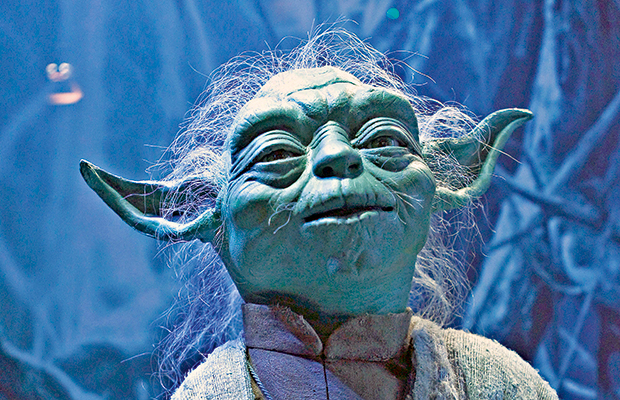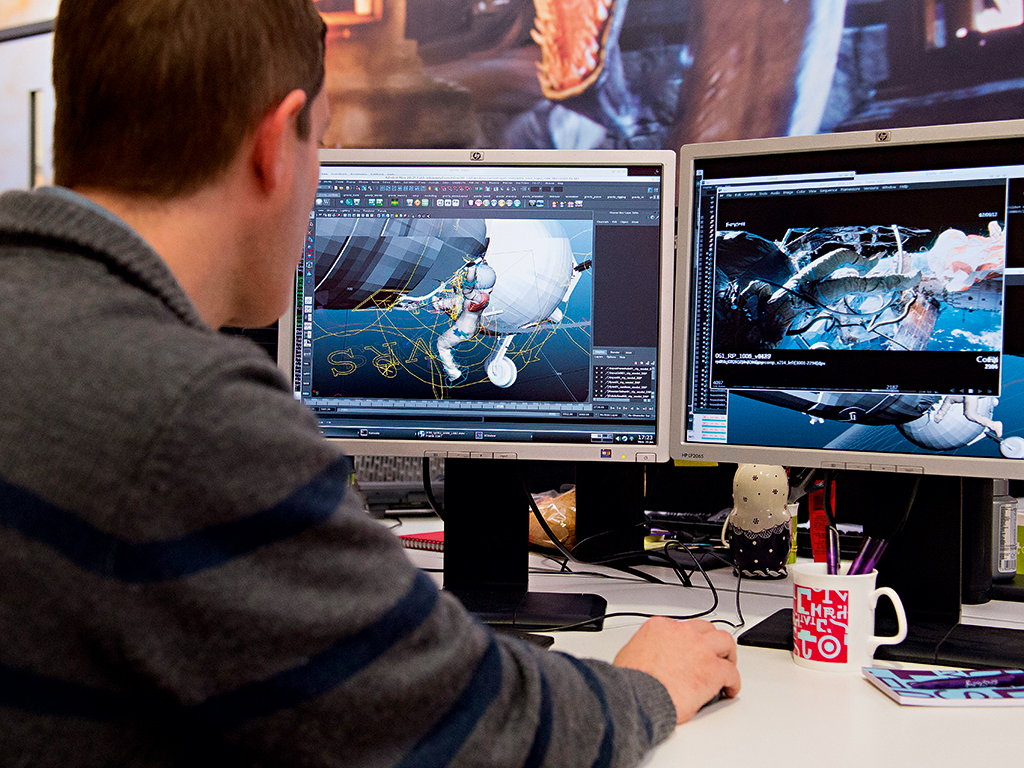How Star Wars changed the special effects industry
The Star Wars franchise has revolutionised the special effects industry twice already, and, as a third trilogy of films prepares to hit the screens, it is likely to change things yet again. Rita Lobo looks at the modern visual effects industry, and how it is in a constant state of flux

The puppet used for Yoda, a key figure in the Star Wars films, was replaced with CGI in later episodes
A long time ago, in a galaxy far, far away, a young cinematographer called George Lucas changed the way film was made. The year was 1977, the far away galaxy in question was an inhospitable barren land known as Hollywood. The young Lucas had a very clear vision and aesthetic in mind when he wrote his space fantasy magnum opus, but the technology available was still woefully inadequate to produce such challenging visuals. Lucas had created – in his storyboards at least – a rich environment filled with weird and wonderful creatures, space battles and hunk of junk spaceships leaping through hyperspace. But at a time when computer generated imagery (CGI) was still in its infancy (having debuted in Richard T Heffron’s Futureworld only a year earlier), it quickly became clear Lucas was going to have to build his universe by hand.
In our universe, almost four decades later, that young Jedi’s creation remains a big deal. Without going into the merits of plot, character and storylines – a debate almost as controversial as arguments over whether Han Solo or Greedo shot first – the way Star Wars was made set a high bar for the future of special effects. The original trilogy (Episodes IV, V and VI) produced between 1977 and 1983 set the gold standard for visual effects. John Dykstra, the special effects designer who worked on the original Star Wars and was chosen by Lucas to head up the director’s visual effects company, Industrial Light & Magic, has described sitting with a group of friends and building models and robots from scratch in order to achieve the realism Lucas was after.
“Back in the days of Star Wars, we kind of walked into an empty warehouse and sat on the floor and went ‘How are we going to do this?’” he told Den of Geek. “The producers, Gary Kurtz of Fox and George Lucas, took an incredible risk by listening to what myself and my collaborators had to say with regard to how to do this, because we were inventing this stuff from scratch. We have a basic toolkit now, in the form of a computer, and so much of it now is programming.”
UK tax rebates
25%
For films spending £20m or less
20%
For films spending over £20m
71%
Growth of UK film production due to tax incentives
1,050
Films claimed rebates between January 2007 and May 2013
£1.1bn
Total tax relief claimed in that time
£22m
Rebate claimed for Thor: The Dark World (believed to be the largest yet)
Dykstra and Lucas used extremely detailed miniatures, animation and a pioneering system of computer-controlled motion photography to create special effects (SFX) that still look fresh today. Star Wars was the first big-budget blockbuster to rely on realistic action scenes and explosions, and essentially invented the techniques to achieve this. But a mere two decades after Dykstra destroyed the Death Star in A New Hope using nothing but a cardboard box and titanium shavings, Lucas turned his back on animatronics and practical effects in favour of expanding his Star Wars universe digitally in the prequel Episodes I, II, and III, released in the late 1990s and early 2000s.
I’ve got a bad feeling about this
For the grace and balance of Lucas’s first trilogy, in which he and Dykstra expertly managed the juxtaposition of pioneering digital effects and animatronic special effects, his last three Star Wars films incited the ire of fans – despite being just as groundbreaking. Star Wars Episode I: The Phantom Menace, released in 1999, featured some of the same elements as A New Hope had 22 years before: the planet Tatooine and the famous gliding landspeeder driven by Luke Skywalker in the original. But the difference was that, in the more recent films, all the effects were created digitally and added in post-production by a talented team of VFX compositors. Across those two trilogies, Lucas revolutionised the industry twice with his approach to visual effects: once as he virtually invented the tools he needed to make his universe come to life, and second when he pushed digital effects further than ever before by building fully rendered characters, cities and spaceships out of computer animation. Now, as Disney prepares to launch the first Star Wars film free from Lucas’ control, the series is set to continue innovating as it turns away from flashy VFX and opts for a more analogue approach to filmmaking, true to its roots.
When Industrial Light & Magic pioneered the process of building whole environments digitally, and then inserting them into the original shots, it opened up a range of opportunities for art directors and filmmakers. Suddenly they were no longer constrained by the impracticalities of having to build every aspect of a scene from scratch, and could bend or break the laws of physics in order to make shots more powerful. But there was a weightlessness to the images created, which cinemagoers found hard to connect with. Jar Jar Binks – one of the key characters in Lucas’s prequel trilogy – is the finest example of this; the character was both annoying and at odds with his environment, and was widely ridiculed by audiences. However, just a few years later, The Lord of the Rings films would introduce audiences to Gollum, and he would become one of the most popular characters of the franchise – despite being created almost entirely through CGI.
Visually, the landscape, cities and characters of the Star Wars prequels were dazzling, but there were issues with how the actors contrasted with the CGI environment, detracting from the films’ stunning visual fabric. Inadvertently, as Lucas was pioneering a new way of making films, and a set of techniques that have become increasingly popular over the last decade and a half, he was both creating a new niche in the visual effects market and making audiences acutely aware of the limitations of the medium at the same time.
“When they introduced the Jar Jar Binks character, they were confident they could completely satisfy the audience with a full CGI character, whereas we have since learned that was not the case,” explains Owen Jackson, a London-based VFX compositor. “Directors today are certain they can tell a story with a full CG character: take Avatar for instance, which was carried by a series of CGI characters. Though that was only in 2009, and it was a tremendous success, audiences of today would already note the difference in the quality of the CGI available in 2014.”
A bright centre to the universe
In the years since the Star Wars prequel trilogy was launched, CGI technology has come along in leaps and bounds, with London emerging as the capital of the special visual effects (VFX) sector. It is a game-changing niche as far as making films is concerned: VFX, even more than conventional special effects and animatronics did in the 1970s, has opened up new worlds and galaxies to be explored in film. It has also helped cement science fiction as a credible genre, rather than a market for teenagers. Take 2014’s Oscar- and BAFTA-winning picture Gravity, which is primarily set in orbit: it is utterly realistic and has, perhaps more than any film since Avatar, helped displace audiences’ fear of CGI-heavy pictures.
VFX has become a rich industry, innovative both in terms of artistic creativity and cutting-edge technology. In the mid-2000s it was JK Rowling’s contractual agreement with Warner Bros that the Harry Potter movie franchise be primarily produced in the UK with British cast and crew that boosted the sector. This surge of activity by industry-leading companies led the UK Government to secure a slew of tax credits in order to incentivise the growth of the sector and compete on a par with other leading industry capitals. According to a recent study by Oxford Economics, film production in the UK would be up to 71 percent smaller if it were not for the government’s tax incentives.
“London and the UK is experiencing an extraordinary amount of film, TV and animation activity as a result of tax credits,” Adrian Wootton, Chief Executive of Film London and the BFI told the Financial Times. “There’s been a huge amount of R&D and expansion. We now have the biggest concentration of VFX in the world, with six of the eight top companies in this sector in London.”

Do or do not
As a result of this unexpected shift to Europe, the production of blockbusters and high budget showstoppers has been fragmented. Where once a film would have been commissioned, shot, cut and launched from a base in Hollywood, today tax incentives and the emergence of tech hubs such as London mean the process of making a film is no longer centralised. This means films can be cheaper to make, but creatively they are much more complicated products. The advent of modern CGI technology means changes can be made to the plot and art direction of a film up to the last seconds of post-production: a process that would have been extremely costly and time-consuming before digital images invaded the shots.
“Directors have gotten used to the ability to continue to make changes throughout production rather than going in with a clear direction,” explains Jackson. This has led to a slew of CGI-heavy but incoherent features that have cost production companies billions of dollars. Take Disney’s 2012 flop John Carter: an epic reworking of a 1917 adventure novel set on Mars, the film left Disney $200m out of pocket.
The film mostly consisted of epic battles with computer-generated beasts, but lacked a discernible plot or emotional focus for the audience to connect with. A CGI environment that is too extensive can leave audiences feeling alienated from the story and the characters, with nothing recognisable to identify with. It is no coincidence Avatar – the highest-grossing film of all time – expertly blends live-action sequences with those created digitally.
Given the damage done to the reputation of CGI by the likes of John Carter and Jar Jar Binks, it wasn’t coincidental that JJ Abrams, the man tasked by Disney to helm the upcoming Star Wars Episode VII, gleefully allowed images of a full-scale Millennium Falcon model and a fleet of X-wing fighter craft to circulate online. Abrams is drawing a line under Jar Jar and embracing the old school sets, props and animatronics that made the original trilogy so popular with fans and critics.
By combining analogue techniques with CGI effects, directors such as Abrams are looking to make up for some of the inevitable shortcomings of both technologies. However, some in the industry believe that, despite Abrams’ high-profile return to analogue, CGI will inevitably take over for good.
“When you watched Transformers, did it feel like the robot characters were real and did it look like they were alive in the same world as [the film’s star] Shia LaBeouf?” wrote Alex Billington, a film critic and industry commentator on firstshowing.net. “When you watched The Dark Knight, did you ever notice one second of CGI, even in Harvey Dent’s burned face? If Hellboy II is out of the question in the argument for practical effects, the next great example is Iron Man, where the late Stan Winston’s armour was completely hand-built and used while shooting. However, could you tell when his armour changed from practical to CGI? I know I never knew the difference and that’s a testament more to the CGI artists than anyone else. That’s not to say that Winston’s work wasn’t amazing, as it certainly was what gave the CG artists a design to work off of, but it shows that the use of CGI is not a bad thing by any means.”

But there is still a long way to go for the industry, especially when it comes to human or humanoid CGI characters. “Creating a fully digital CGI human face is the holy grail of visual effects, and we are nowhere near that yet,” says Jackson. “That is why studios like Pixar have very stylised human faces, because they cannot achieve a realistic enough final product. The realism that you naturally get from an animatronics face is more believable because it’s an analogue photographic technique that is easier for audiences to believe. People are so used to looking at human faces that they can pick up on even the most minute discrepancies and nuances of the animation: if anything is off, audiences will spot it even if they cannot put their finger on why it looks wrong.”
It is not a coincidence then that the most successful CGI characters – such as Gollum in The Lord of the Rings trilogy and the Na’vi people in Avatar – were created by blending real actors with many layers of CGI images, rather than by animating a character from scratch. Andy Serkis, who played Gollum, has helped pioneer these types of performance capture roles, which have allowed CGI characters to become more realistic.
The fact of the matter is directors no longer have to choose between including traditional special effects and animatronic models or going fully digital by filming sequences using a green screen and building the shots later – although many still do. The most successful products combine a mixture of both disciplines. This world is not one of light and dark: but it is, like the mystical Force in Lucas’ sci-fi epic, in need of balance.













